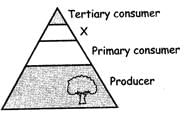Test: Ecosystem - 3 - Class 5 MCQ
20 Questions MCQ Test - Test: Ecosystem - 3
In a jungle there exists many different types of animals. Some of these animals eat plants while some eat meat. All these animals are interdependent on each other. A huge animal - elephant - eats only plants. Which type of consumer is he?
| 1 Crore+ students have signed up on EduRev. Have you? Download the App |
Read the sentences and choose the correct option.
A: The climatic condition in all the biomes is same.
B: Every country has its own specific 6 biomes.
Read the sentences and choose the correct option.
A: Food webs and food chains are synonyms.
B: Food chain is a part of food web.
Complete the food chain with the correct option. Plant → grasshopper → ____? ____→ Snake.
Below are given the parts of a food chain. Which of the arrangements is in the correct order?


Which of the following describes the process of photosynthesis?
Lakshmi Prasad, a small farmer grows wheat on his land. He is very scared of snakes. Whenever he encounters a snake he kills it without knowing its adverse effect on the ecosystem. As a nature lover how will you stop him from killing snakes?
Directions: An ecosystem includes soil, atmosphere, heat and Light from the sun, water and living organisms. Soil is a critical part of an ecosystem. It provides important nutrients for the plants in an ecosystem. The atmosphere provides oxygen and carbon dioxide for the plants and animals. In a lake ecosystem, the sun hits the water and helps the algae grow. Algae produces oxygen for animals like fish and provides food for microscopic animals.
Q. Which of the following is not a part of ecosystem?
Directions: An ecosystem includes soil, atmosphere, heat and Sight from the sun, water and living organisms. Soil is a critical part of an ecosystem. It provides important nutrients for the plants in an ecosystem. The atmosphere provides oxygen and carbon dioxide for the plants and animals. In a lake ecosystem, the sun hits the water and helps the algae grow. Algae produces oxygen for animals like fish and provides food for microscopic animals.
Q. What does algae do in ecosystem?
Directions: An ecosystem includes soil, atmosphere, heat and Sight from the sun, water and living organisms. Soil is a critical part of an ecosystem. It provides important nutrients for the plants in an ecosystem. The atmosphere provides oxygen and carbon dioxide for the plants and animals. In a lake ecosystem, the sun hits the water and helps the algae grow. Algae produces oxygen for animals like fish and provides food for microscopic animals.
Q. All the living organisms get oxygen and carbon dioxide from?
Directions: Fill in the blanks Desert ecosystems are located in regions that receive very less __(1)__ .
Due to extremely high __(2)__, low water availability and intense __(3)__, fauna and flora are scarce and poorly developed. Identify (1) in the question.
Directions: Fill in the blanks Desert ecosystems are located in regions that receive very less __(1)__ .
Due to extremely high __(2)__, low water availability and intense __(3)__, fauna and flora are scarce and poorly developed. Identify (2) in the question.
Directions: Fill in the blanks Desert ecosystems are located in regions that receive very less __(1)__ .
Due to extremely high __(2)__, low water availability and intense __(3)__, fauna and flora are scarce and poorly developed. Identify (3) in the question.
Roman has a small garden in his house. He noticed one day that some rabbits, goats and birds started eating his plants so he decided to cover the garden with shed and fencing all around, due to this plants started dying one by one. As his friend what will you tell to convince him not to cover the garden?



















